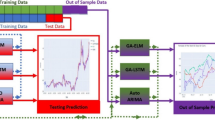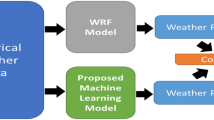Abstract
Artificial neural networks are widely applied for different forecasting applications including rainfall forecasting. The climate input features and parameters for neural networks highly affect the overall performance of the prediction model. Therefore, an appropriate approach for the selection of features and parameters is needed. In this paper, a novel approach is proposed to select the input features and neural network parameters. A hybrid genetic algorithm that combines natural reproduction and particle swarm optimization characteristics was developed to select the best input features and network parameters for each month. The developed model was compared against alternative climate and network parameters feature selection model, climate feature selection model and climatology where a better accuracy was recorded with the proposed model. The skill score against the three alternative climate models was 17.41, 21.68 and 32.12%, respectively. The aggregated time series of the proposed model showed a root-mean-square error of 141.67 mm for a location with 3553.00 mm annual average.









Similar content being viewed by others
References
Abhishek K, Singh MP, Ghosh S, Anand A (2012) Weather forecasting model using artificial neural network. Procedia Technol 4:311–318. doi:10.1016/j.protcy.2012.05.047
Ahmadi MA (2011) Prediction of asphaltene precipitation using artificial neural network optimized by imperialist competitive algorithm. J Pet Explor Prod Technol 1:99–106. doi:10.1007/s13202-011-0013-7
Ahmadi MA (2012) Neural network based unified particle swarm optimization for prediction of asphaltene precipitation. Fluid Ph Equilib 314:46–51. doi:10.1016/j.fluid.2011.10.016
Ahmadi MA, Ahmadi A (2016) Applying a sophisticated approach to predict CO\(_2\) solubility in brines: application to CO\(_2\) sequestration. Int J Low-Carbon Technol 11:325–332. doi:10.1093/ijlct/ctu034
Ahmadi MA, Golshadi M (2012) Neural network based swarm concept for prediction asphaltene precipitation due to natural depletion. J Pet Sci Eng 98–99:40–49. doi:10.1016/j.petrol.2012.08.011
Ahmadi MA, Shadizadeh SR (2012) New approach for prediction of asphaltene precipitation due to natural depletion by using evolutionary algorithm concept. Fuel 102:716–723. doi:10.1016/j.fuel.2012.05.050
Ahmadi MA, Soleimani R, Lee M, Kashiwao T, Bahadori A (2015) Determination of oil well production performance using artificial neural network (ANN) linked to the particle swarm optimization (PSO) tool. Petroleum 1:118–132. doi:10.1016/j.petlm.2015.06.004
Chaudhuri S, Chattopadhyay S (2005) Neuro-computing based short range prediction of some meteorological parameters during the pre-monsoon season. Soft Comput 9:349–354. doi:10.1007/s00500-004-0414-3
Ding H, Dong W (2016) Chaotic feature analysis and forecasting of Liujiang river runoff. Soft Comput 20:2595–2609. doi:10.1007/s00500-015-1661-1
Everingham YL, Clarke AJ, Chen CCM, Gorder Sv, McGuire P (2007a) Exploring the capabilities of a long lead climate forecasting system for the NSW sugar industry. In: Proceedings of the 2007 conference of the Australian society of sugar cane technologists held at Cairns, Queensland, Australia, Australian Society of Sugar Cane Technologists, Mackay, Australia, 8–11 May 2007
Everingham YL, Clarke AJ, Van Gorder S (2007b) Long lead rainfall forecasts for the Australian sugar industry. Int J Climatol 28:111–117. doi:10.1002/joc.1513
Gnana Sheela K, Deepa SN (2014) Performance analysis of modeling framework for prediction in wind farms employing artificial neural networks. Soft Comput 18:607–615. doi:10.1007/s00500-013-1084-9
Haidar A, Verma B (2016) A Genetic algorithm based feature selection approach for rainfall forecasting in sugarcane areas. Paper presented at the 2016 IEEE symposium series on computational intelligence, Athens, Greece
Hawthorne S, Wang QJ, Schepen A, Robertson D (2013) Effective use of general circulation model outputs for forecasting monthly rainfalls to long lead times. Water Resour Res 49:5427–5436. doi:10.1002/wrcr.20453
Henley BJ, Gergis J, Karoly DJ, Power S, Kennedy J, Folland CK (2015) A tripole index for the Interdecadal Pacific Oscillation. Clim Dyn 45:3077–3090. doi:10.1007/s00382-015-2525-1
Jaedong L, Jee-Hyong L (2016) Constructing efficient regional hazardous weather prediction models through big data analysis. Int J Fuzzy Log Intell Syst 16:1–12
Jungwon Y, Sungshin K (2016) Locally-weighted polynomial neural network for daily short-term peak load forecasting. Int J Fuzzy Log Intell Syst 16:163–172
Kishtawal CM, Basu S, Patadia F, Thapliyal PK (2003) Forecasting summer rainfall over India using genetic algorithm. Geophys Res Lett 30:n/a-n/a. doi:10.1029/2003GL018504
Mekanik F, Imteaz MA, Gato-Trinidad S, Elmahdi A (2013) Multiple regression and artificial neural network for long-term rainfall forecasting using large scale climate modes. J Hydrol 503:11–21. doi:10.1016/j.jhydrol.2013.08.035
Meng X (2013) Weather forecast based on improved genetic algorithm and neural network. In: Zhong Z (ed) Proceedings of the international conference on information engineering and applications (IEA) 2012, vol 4. Springer, London, pp 833–838. doi:10.1007/978-1-4471-4853-1_102
Moustris KP, Larissi IK, Nastos PT, Paliatsos AG (2011) Precipitation forecast using artificial neural networks in specific regions of Greece. Water Resour Manag 25:1979–1993. doi:10.1007/s11269-011-9790-5
Nagahamulla H, Ratnayake U, Ratnaweera (2011) A Monsoon rainfall forecasting in Sri Lanka using artificial neural networks. In: 2011 6th international conference on industrial and information systems, 16–19 Aug 2011. pp 305–309. doi:10.1109/ICIINFS.2011.6038085
Nagahamulla H, Ratnayake U, Ratnaweera A (2012) An ensemble of artificial neural networks in rainfall forecasting. In: 2012 international conference on advances in ICT for emerging regions (ICTer), 12–15 Dec 2012. pp 176–181. doi:10.1109/ICTer.2012.6423032
Nagahamulla H, Ratnayake U, Ratnaweera A (2014) Selecting most suitable members for neural network ensemble rainfall forecasting model. In: Herawan T, Ghazali R, Deris MM (eds) Recent advances on soft computing and data mining: Proceedings of the first international conference on soft computing and data mining (SCDM-2014), Universiti Tun Hussein Onn Malaysia, Johor, Malaysia, 16th–18th June 2014. Springer, Cham, pp 591–601. doi:10.1007/978-3-319-07692-8_56
Nastos PT, Paliatsos AG, Koukouletsos KV, Larissi IK, Moustris KP (2014) Artificial neural networks modeling for forecasting the maximum daily total precipitation at Athens, Greece. Atmos Res 144:141–150. doi:10.1016/j.atmosres.2013.11.013
Philip NS, Joseph KB (2003) A neural network tool for analyzing trends in rainfall. Comput Geosci 29:215–223. doi:10.1016/S0098-3004(02)00117-6
Pui A, Sharma A, Santoso A, Westra S (2012) Impact of the El Niño–Southern Oscillation, Indian Ocean dipole, and southern annular mode on daily to subdaily rainfall characteristics in east Australia. Mon Weather Rev 140:1665–1682
Rivero CR, Patiño HD, Pucheta JA (2015) Short-term rainfall time series prediction with incomplete data. In: 2015 international joint conference on neural networks (IJCNN), 12–17 July 2015. pp 1–6. doi:10.1109/IJCNN.2015.7280315
Shafiei A, Ahmadi MA, Zaheri SH, Baghban A, Amirfakhrian A, Soleimani R (2014) Estimating hydrogen sulfide solubility in ionic liquids using a machine learning approach. J Supercrit Fluids 95:525–534. doi:10.1016/j.supflu.2014.08.011
Sumathi S, Surekha P (2010) Computational intelligence paradigms: theory and applications using MATLAB, vol Book, Whole. CRC Press, Boca Raton
Wilks DS (2011) Forecast verification. In: Daniel SW (ed) International geophysics, vol 100. Academic Press, Oxford, UK, pp 301–394. doi:10.1016/B978-0-12-385022-5.00008-7
Wu J, Long J, Liu M (2015) Evolving RBF neural networks for rainfall prediction using hybrid particle swarm optimization and genetic algorithm. Neurocomputing 148:136–142. doi:10.1016/j.neucom.2012.10.043
Zhi-liang W, Hui-hua S (2010) Rainfall prediction using generalized regression neural network: case study Zhengzhou. In: 2010 international conference on computational and information sciences (ICCIS), 17–19 Dec 2010. pp 1265–1268. doi:10.1109/ICCIS.2010.312
Acknowledgements
This study was funded by CQU Research Division.
Author information
Authors and Affiliations
Corresponding author
Ethics declarations
Conflict of interest
Ali Haidar declares that he has no conflict of interest. Brijesh Verma declares that he has no conflict of interest.
Ethical approval
This article does not contain any studies with human participants or animals performed by any of the authors.
Additional information
Communicated by V. Loia.
Rights and permissions
About this article
Cite this article
Haidar, A., Verma, B. A novel approach for optimizing climate features and network parameters in rainfall forecasting. Soft Comput 22, 8119–8130 (2018). https://doi.org/10.1007/s00500-017-2756-7
Published:
Issue Date:
DOI: https://doi.org/10.1007/s00500-017-2756-7




